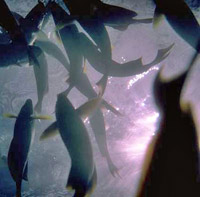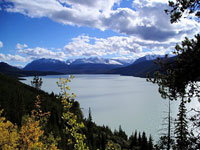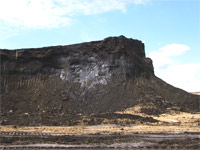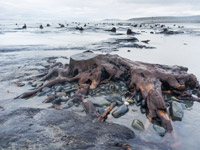
News |
- Manitoba Promises Beluga Whale Protection
- Spread Earth Democracy: Vandana Shiva to Winnipeg
- EPA Moves to Block Alaska Pebble Mine
- Line 9: Pipeline Disaster Waiting To Happen
- Manitoba Gives Louisiana Pacific 6 Year Free Pass
- BC Grizzly Bear Trophy Hunting
- Grandmothers Call For Healing Water Prayers
- Taseko New Prosperity Mine Rejected Again
- Tar Sands Failing On Tailings
- Sochi: Olympics and the Environment
- Environment, Fisheries Ministers Break Law: SARA
- Ancient Forest Exposed by Violent UK Storms
| Manitoba Promises Beluga Whale Protection | 7 March 14 |

The proposed measures are no small task, as the western coast of Hudson's Bay shelters roughly 60,000 beluga whales annually – one of the largest concentrations in the world. The ecological integrity of this unique location is important, as the whales use these waters for feeding, giving birth, and nursing their young while protected from predators in the shallow estuary waters. Displacement from these shallow waters would result in catastrophic consequences for the beluga calves due to orca whales patrolling the deeper waters. Minister Makintosh has an immediate opportunity to protect the estuaries and fjords on the west coast of Hudson's Bay. These were identified as 'Areas of Special Interest' by his department, and the minerals sector agreed to their protection. First Nations consultations remain before protected waters and lands actions. View March 2, 2014 CBC News articleView March 2, 2014 Montreal Gazette article View Ocean's North Hudson Bay Beluga Project article Source:
CBC News
|
|
 Print version Print version |
Top |
| Spread Earth Democracy: Vandana Shiva to Winnipeg | 7 March 14 |

Earth Democracy is a concept referring to a pacifist approach to democracy for all life on earth, with the goal of empowering and rejuvenating living cultures and living economies. Dr. Shiva's teachings promote every living being's right to food security, right to clean water, and right to life. For those unable to attend in person, this lecture will be video recorded and broadcasted live via livestream.com. Event organizers, Winnipeg-based food freedom rights group The Powers House Producers, strongly encourage communities to host their own virtual lecture through this live stream. Communities are also invited to share their knowledge of traditional foods unique to their cultures, and can post photos of these special meals through a common Tumblr account. For information on how to follow the live stream, how to share your culture's feast foods, or more on Dr. Vandana Shiva's Earth Democracy, please contact powerhouseproducers@gmail.com. View Facebook event pageVisit Navdanya website View Vandana Shiva information page on Common Dreams View Growing Local 2014 Workshop Descriptions Source:
Facebook
|
|
 Print version Print version |
Top |
| EPA Moves to Block Alaska Pebble Mine | 7 March 14 |

Gina McCarthy, administrator for the EPA, stresses that this is only a temporary block for the development and that decisions are in no way final. A four-step process is now underway that may eventually result in permanent protection of Bristol Bay, the area in which this mine would be located. This announcement is hailed by the alliance of concerned fishermen, local First Nations groups, and environmentalists who have been opposing the mine and arguing its location in the headwaters of major river systems would endanger the thriving salmon population that use those waters for their annual 'run' up the rivers. "Today, EPA is taking a significant step forward in our efforts to insure that the world's most productive salmon fishery is safe from the risks that it faces from what could be one of the largest mines on earth," McCarthy stated in an interview. View March 5, 2014 Huffington Post articleView February 14, 2014 Indian Country Today Media Network article View December 8, 2011 United States Environmental Protection Agency presentation View United States Environmental Protection Agency Bristol Bay page Source:
Huffington Post
|
|
 Print version Print version |
Top |
| Line 9: Pipeline Disaster Waiting To Happen | 7 March 14 |

The 141-page decision on the controversial Line 9 comes some four months after the federal regulator held public hearings on the Calgary-based company's proposal. "People have serious concerns about the safety of this pipeline because it's old and leaky," said Gillian McEachern a spokeswoman for Environmental Defence, which had called on the NEB to require Enbridge to carry out hydrostatic testing, which uses water to check for cracks and breaches. New rules helped the NEB prevent the general public from participating in the Line 9 hearings – forcing anyone who wanted to even write a letter to fill out a 9 page application for permission to do so. The gutting of Canada's long-standing federal environmental laws over the past two years meant Line 9 was the first major project to be exempt from undergoing an environmental assessment. That left the public and the NEB without critical independent information about the risks of the project. View CTV W5 Line 9 Pipeline infographicView March 7, 2014 Environmental Defence article View March 7, 2014 Common Dreams article View March 6, 2014 CTV News article View January 9, 2013 CBC News article View May 2, 2012 Huffington Post article |
|
 Print version Print version |
Top |
| Manitoba Gives Louisiana Pacific 6 Year Free Pass | 28 February 14 |

The company made a commitment to update its Forest Management Plan based on a new moose strategy. This western Manitoba FMU is in the region of the province where moose are in the most trouble, and where the hunt has been closed. Conditions have been placed on this LP extension, but they are weak. It could be noted that the dramatic decrease in moose population in the region coincides with the time period since LP began operations in the region. The status of government consultations with affected First Nations regarding: the extension of the legal agreement, extension of the forest management licence, or the moose strategy is not know at this time.
View Louisiana Pacific page in the Environment Act Public Registry |
|
 Print version Print version |
Top |
| BC Grizzly Bear Trophy Hunting | 28 February 14 |

One of the areas to be opened to trophy grizzly hunting is the province's Kootenay region, which runs along the south of the province, close to Washington, Idaho and Montana. The American Endangered Species Act, which lists grizzly bears as "threatened", protects the species in the lower 48 states. Having the Kootenay region open to hunting could likely infringe on protected American populations. Since 2001, an estimate of 253 grizzlies are killed for sport in British Columbia each year. Andrew Weaver, Green Party MLA in BC, and a climate scientist at the University of Victoria, is concerned about the long-term implications that a changing climate will have on this already threatened species. Opposed to the concept of trophy hunting in general, Weaver states, "I don't even like to call it a 'hunt'. It mixes things up with the hunters who hunt for food. I call it trophy killing." Polls show that 80% of BC residents share views with Weaver, opposing trophy hunting of grizzlies due to their symbolic role as an animal of the BC wilderness, and recognizing their highly important ecological role. View February 21, 2014 The Guardian articleView February 17, 2014 CBC News article View January 8, 2014 CBC News article View December 6, 2013 The Globe and Mail article View November 6, 2013 CBC News article Source:
The Guardian
|
|
 Print version Print version |
Top |
| Grandmothers Call For Healing Water Prayers | 28 February 14 |

This recognition of sisterhood, motherhood and womanhood will take place on World Water Day, March 22, at the sacred Montezuma Well, in Yavapai County, Arizona, in a sacred ceremony conducted by the women of the International Council of Thirteen Indigenous Grandmothers. The Montezuma Well is an ancient site, important to humankind for millennia, and is sanctuary to local indigenous peoples such as the Yavapai-Apache tribe, the Hopi tribe, and the Navajo tribe. For those unable to attend in person, the practice can be conducted anywhere so long as prayers are made with feelings of gratitude and respect for the healing and life-giving powers of our waters. View International Council of Thirteen Indigenous Grandmothers StatementVisit In the Name of the Mother website View International Council of 13 Indigenous Grandmothers Wikipedia page View The Council of Canadians World Water Day page Source:
International Council of Thirteen Indigenous Grandmothers
|
|
 Print version Print version |
Top |
| Taseko New Prosperity Mine Rejected Again | 28 February 14 |

Opponents of the development hailed the federal decision. Top on the list of opponents to the mine are the First Nations of the Tsilhqot'in National Government, which comprises of six individual communities. Fish Lake is considered to be sacred to the peoples of the Tsilhqot'in, and any damage to the lands and headwaters would affect them not only physically, but also culturally. The second rejection of the proposed mine comes as relief to these communities, and they are urging Taseko to give up the fight. As Chief Roger William of the Xeni Gwet'in First Nation said in a statement, "We call on the province and Taseko to acknowledge that this is the end, to pack up their tents and go home. The company has wasted too many resources and time on a project that was first rejected in 1995. It is time to look elsewhere and leave us in peace." View February 27, 2014 Indian Country Today Media Network articleView February 27, 2014 The Globe and Mail article View February 26, 2014 CBC News article View February 26, 2014 The Globe and Mail article View February 26, 2014 The Vancouver Sun article View October 31, 2013 New Prosperity Gold-Copper Mine Project report Source:
The Globe and Mail
|
|
 Print version Print version |
Top |
| Tar Sands Failing On Tailings | 28 February 14 |

"Well, it looks like what they've seen is that in fact the tailings ponds are leaking," said Bill Donahue, environmental scientist with the oilsands advisory committee. "They found also not only are those tailings ponds leaking, but it looks like it is flowing pretty much from those tailings ponds, through the ground and into the Athabasca River." The Environment Canada study used new technology to actually fingerprint the mix of groundwater chemicals in the area. It found the mix of chemicals from tailings is different from that in naturally occurring bitumen deposits. That tailings mix, which contains toxic chemicals, is found in groundwater around mining operations, but not in areas away from development. The Pembina Institute, an environmental research group, has long said the ponds leak. Analyst Erin Flanagan said the new research shows even Pembina underestimated how much. "As we continue to expand the industry, we're also expanding the production of tailings waste." View February 26, 2014 Vancouver Observer articleView February 21, 2014 Environmental Defence article View February 21, 2014 CBC News article View January 21, 2014 Environmental Science & Technology article View November 13, 2013 Pembina Institute report View Oil Sands Reality Check website |
|
 Print version Print version |
Top |
| Sochi: Olympics and the Environment | 28 February 14 |

Russia's drive to host the Winter Games, no matter the cost, also reflects their long history of staging mega-projects at the state's expense, according to Dr. Lowell Barrington, chair of the Department of Political Science at Marquette University and an expert on Russian politics and nationalism. When Russia originally made a bid for the Olympics seven years ago, President Vladmir Putin promised a list of environmentally friendly measures: zero waste, heavy investment in alternative energy, restoration of endangered species to the surrounding areas, and the first carbon neutral Games in history. None of these targets have been realized and some have even worsened. View February 25, 2014 Nicholas School of the Environment articleView February 22, 2014 CBC News article View February 17, 2014 The Ecologist article View February 12, 2014 Think Progress article View February 12, 2014 BBC News Europe article View February 10, 2014 Amnesty International article View January 20, 2014 Time article |
|
 Print version Print version |
Top |
| Environment, Fisheries Ministers Break Law: SARA | 21 February 14 |

"We find ourselves having to continue to go back to court to force the government to follow some fairly clear language in the act," Devon Page of Ecojustice stated outside the court. Shortcomings emerged in this Federal Court case. For example, the ministries did not provide recovery strategies after all four species were listed under SARA, and missed formal deadlines by up to six and a half years. Additionally, recovery strategies or management plans are at present required for 192 species, of these 163 are overdue. Particularly relevant is that many overdue recovery plans have an impact on the review of the controversial Northern Gateway Pipeline. The government did not challenge the evidence presented in court, the judgment did state, "they do deny that recovery strategies have been intentionally delayed in order to facilitate industrial development." There is no penalty for the government departments failing to meet deadlines under SARA. The court did grant $22,500 to each of the five environmental organizations (Wilderness Committee, Sierra Club, David Suzuki Foundation, Wildsight, Greenpeace) that filed the suit through Ecojustice. View February 14, 2014 Toronto Star articleView February 14, 2014 CTV News article View January 25, 2014 Huffington Post article View Nigel Banks case study Visit Wilderness Committee website Visit Sierra Club Canada website Visit David Suzuki Foundation website Visit Wildsight article Visit Greenpeace Canada website Source:
Toronto Star
|
|
 Print version Print version |
Top |
| Ancient Forest Exposed by Violent UK Storms | 21 February 14 |

Source: The Guardian
Previously a landscape of peatlands, oak, alder and birch, rising sea levels, a changing climate, and increasing layers of peat suffocated the forest roughly 4,500 years ago, stopping tree growth. However, the acidity of the peatlands preserved and fossilized the tree stumps, creating an eerie landscape revealed only when extreme storms arise in the area. These stumps are only exposed during particularly violent storm surges, and will become covered by sand once tides return to normal. View February 21, 2014 The Telegraph articleView February 21, 2014 The Guardian article View February 20, 2014 The Guardian article Source:
The Guardian
|
|
 Print version Print version |
Top |


 RSS Feeds:
RSS Feeds: